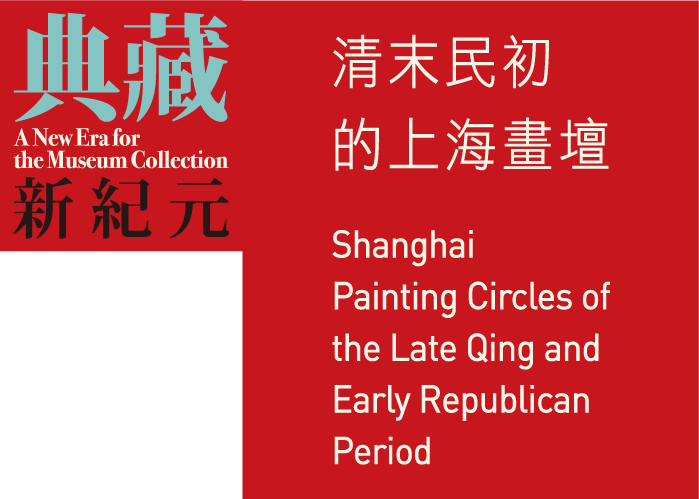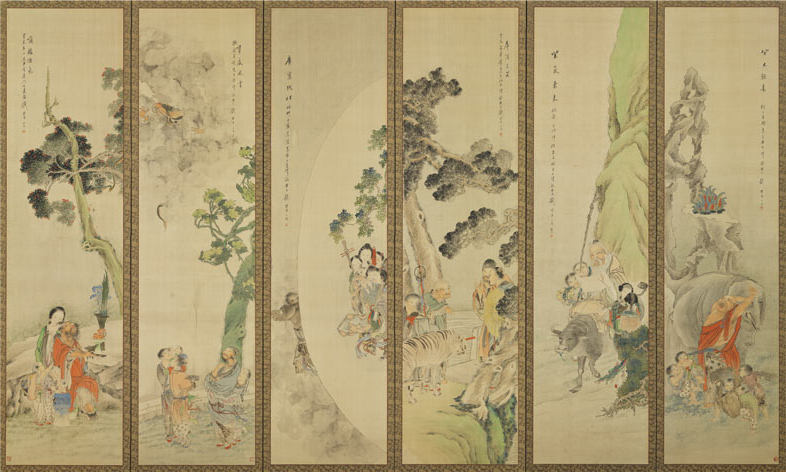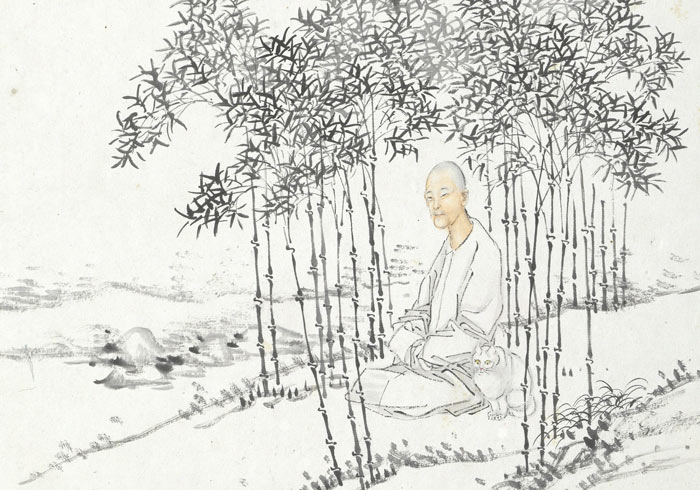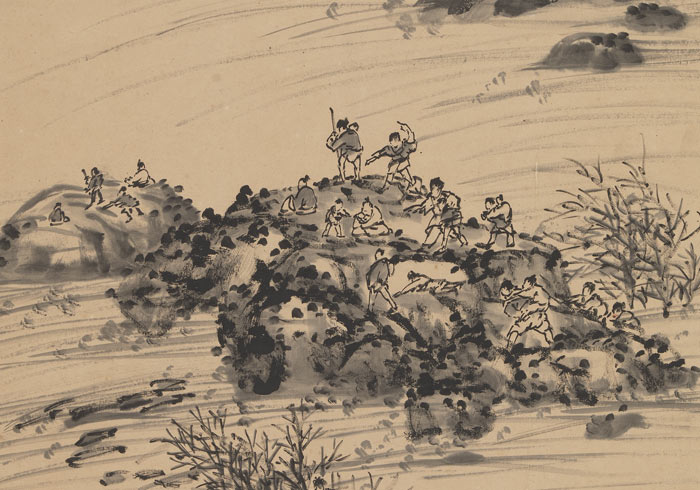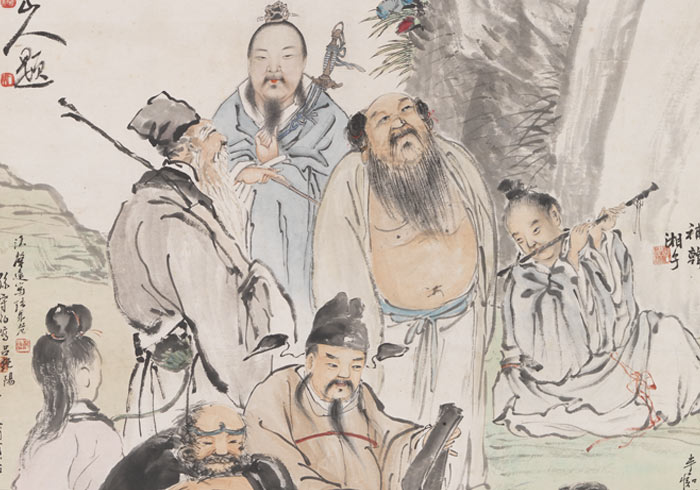The flourishing market for painting and calligraphy had a profound impact on the production of art. Although such traditional forms of patronage, such as personal connections and making direct or indirect requests for art, still existed, it became increasingly common in late-Qing Shanghai to go to art shops and make a deal. These art shops even had a "profit scale" (price standards) for particular artists so that a customer could pick and choose a desired work at a set price. Consequently, the buyer did not have to meet the artist as art production became increasingly commercialized. In the late Qing, artists also often formed associations, some of which established a price list for cooperative works, thereby promoting the development of artistic collaboration. The selection of works in this section includes Wu Tao's "Scenes of Traveling in the Past," which represents traditional patronage, and Ren Yi's "Chen Ping Divides the Meat" done for the art market. Several collaborative paintings are also found here, such as "Going to the Peach Gathering of Immortals in Collaboration." Featuring eleven artists, this work is the one in the National Palace Museum with the most people involved in its production. Finally, Wu Changshi's "Red and White Chrysanthemums" was signed for a Japanese man named "Mr. Hashimoto," offering a glimpse at the overseas spread of Shanghai painting.
Twelve Screen Panels of Figures
- Qian Hui'an (1833-1911), Qing dynasty
- Screen, ink and colors on silk, 157.6 x 39.8 cm
Qian Hui'an (style name Jisheng, sobriquet Qingxi qiaozi, studio name "Shuangguan Tower"), a native of Baoshan in Jiangsu, excelled at painting figures in the fine-line style. He also was once involved in producing New Year's paintings, his works entering all walks of society. He was the first president of the Yu Garden Calligraphy and Painting Charitable Association.
This set of paintings is mounted onto two screens, each with six panels for a total of twelve works that follow and reference the cycle of animals in the Chinese zodiac via stories with auspicious themes. They include a range of subjects, such as children, ladies, religious figures, and animals of all sorts, creating a lively and busy display. Though each work is independent, the compositions complement each other in a subtle way. Qian enjoyed layering figures to add a sense of complexity to painting surfaces. His lines are angular with vigorous flourishes, the stops and starts of the brush clearly evident. Qian's figures, moreover, stand out for the faces, his use of washes creating a unique volumetric effect for a sense of weight. The affected poses of his figures and the beautiful colors made Qian's works quite popular at the time.
Scenes of Traveling in the Past
- Wu Tao (1840-1895), Qing dynasty
- Album leaf, ink and colors on paper, 33.2 x 40.9 cm
Wu Tao (style name Botao ; sobriquets Shulin and Sulin) had a studio known as "Lailu Thatched Cottage." A native of Shimen in Zhejiang, he was good at painting landscapes and flowers. In the 1860s he took refuge in Shanghai and later made a living selling his paintings there and in Hangzhou. Along with Wu Guxiang and Wu Changshi, they were known as the "Three Wus."
This album was done between 1887 and 1892 at the request of Shen Luting of Huzhou as a record of his travels. Shen's journeys took him to Hangzhou, Jiaxing, Suzhou, Shanghai, and Huzhou, and he asked contemporary scholars of renown for inscriptions. Among the leaves are "Viewing the Sea at Wusong" and "Sitting Alone by Tranquil Bamboo," which feature portraits of Shen first painted by Sha Fu and Qian Hui'an, respectively, and then with Wu Tao filling in the scenery. It makes this an example of someone else taking the initiative to ask painters to work together. The latter leaf also shows a male accompanied by a cat, a rare combination in Chinese painting.
Floodwaters Overflowing
- Wang Zhen (1867-1938), Republican period
- Hanging scroll, ink on paper, 122.8 x 44.1 cm
This painting depicts the Beijing-Zhili Flood of 1917, being done not long after news of the disaster had spread. Downpours in the middle of the night led to mass flooding of surrounding lowlands, drowning more than a hundred people and leaving countless numbers homeless. Although Wang Zhen was in Shanghai at the time and did not personally witness the disaster, he nonetheless picked up his brush and used the "level distance" method of traditional Jiangnan southern landscape painting to show floodwaters overwhelming roads and buildings. He dramatically portrays old and young alike scurrying to rooftops, high ground, and trees to escape the floodwaters as others struggle in the water to avoid being drowned. This is one of the few works in traditional Chinese art on the subject of natural disasters.
Wang Zhen, a prominent businessman in Shanghai, once served as director of the Yu Garden Calligraphy and Painting Charitable Association. On several occasions, he led the cause of doing art to raise funds for disaster relief. This work is most likely a charitable product of his effort to raise funds for the needy.
Going to the Peach Gathering of Immortals in Collaboration
- Wang Zhen (1867-1938) et al., Republican period
- Hanging scroll, ink and colors on paper, 133 x 68 cm
This painting depicting the Eight Immortals, done in 1935, features the hand of eleven artists, the most of any work in the collection of the National Palace Museum. Gao Jun (1900-1960, style name Shangzhi) painted Li Tieguai; Kong Xiaoyu (1899-1984) depicted Lan Caihe; Xiong Songquan (1884-1961) did He Xiangu; Lu Shaopo rendered Cao Guojiu; Wang Shengyuan (1889-1969) painted Zhang Guolao; Banchi depicted Han Zhongli; Sun Shoubo rendered Lü Dongbin; and Zhang Shengyong (1875-1949, style name Hui'an) painted Han Xiangzi. Li Run (1884-1947, style name Fangyuan) added the bats and crane to express the idea of "Prosperity and Longevity Complete." Wang Kun (1877-1946, style name Zhongshan) then filled in the landscape background, while Wang Zhen (1867-1938) inscribed the title.
Though obviously a birthday painting, it lacks a dedicatory inscription for the recipient, so perhaps the artists and buyer did not know each other. A single painting bringing together three generations of artists in all their different styles would have made this work a bargain.
